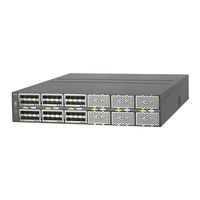Netgear M4300-96X Manuals
Manuals and User Guides for Netgear M4300-96X. We have 2 Netgear M4300-96X manuals available for free PDF download: User Manual, Hardware Installation Manual
Netgear M4300-96X User Manual (704 pages)
Fully Managed Stackable Switches
Table of Contents
-
-
Using SNMP28
-
-
-
Time65
-
DHCP L2 Relay103
-
Configure SNMP126
-
Configure LLDP133
-
Configure ISDP151
-
Timer Schedules157
-
-
-
Stack NSF163
-
-
Configure Vlans178
-
View VLAN Status186
-
Auto-Voip198
-
Iscsi Overview203
-
-
Multicast231
-
IGMP Snooping233
-
Configure MVR252
-
Port Settings262
-
Loop Protection279
-
-
-
Manage Routes285
-
-
View Statistics292
-
-
Ipv6305
-
VLAN Overview322
-
Configure RIP330
-
-
-
Configure OSPF347
-
Configure Ospfv3378
-
-
-
-
-
Qos Overview458
-
Class of Service458
-
-
-
-
Protect Ports549
-
-
-
-
Configure Sflow648
-
-
File Management668
-
Troubleshooting670
-
Ping Ipv4670
-
Ping Ipv6672
-
Traceroute Ipv4673
-
Traceroute Ipv6675
-
Packet Capturing677
-
-
Advertisement
Netgear M4300-96X Hardware Installation Manual (38 pages)
Fully Managed Stackable Switch
Table of Contents
-
-
-
Front Panel12
-
Back Panel13
-
System Leds14
-
-
-
Reset Button21
-
USB Port21
-
-

